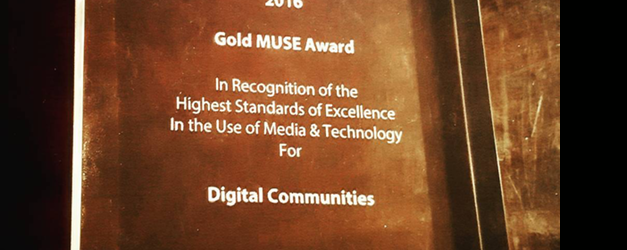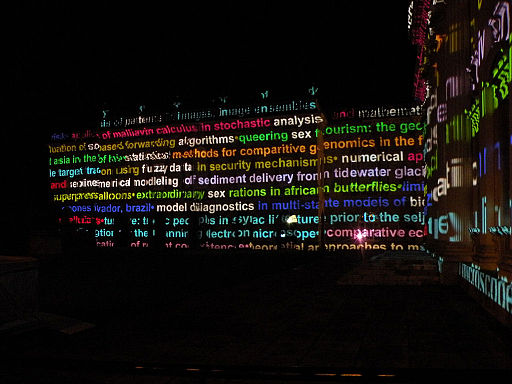Tag: online communites
All that Glitters is GLAM: Gold MUSE Awards

The Smithsonian Transcription Center won a Gold MUSE Award for Digital Communities from the Alliance of Media & Technology in May at the Alliance of American Museum conference in Washington, D.C. I’m delighted that the efforts of our team of volunteers, staff members who share so much time and knowledge, and the Office of the Chief Information Officer were acknowledged formally by this award. We do it together and we continue to grow.
Here is what the juries had to say about the Transcription Center:
“The Smithsonian Institution Transcription Center is a volunteer-supported transcription website at a large scale. The website is smooth and easy to use, participation is rewarding, and the whole experience reflects well on the Smithsonian brand. The jury especially appreciates the way volunteers are made to feel special.” (via Dacia Macengill’s post for the Center for the Future of Museums)
As annual awards from The international Alliance Media & Technology Professional Network, The MUSE Awards “are presented to institutions or independent producers who use digital media to enhance the GLAM experience and engage audiences. The MUSE awards celebrate scholarship, community, innovation, creativity, education and inclusiveness.”
Learn more about the 2016 winners: fabulous, well-designed, and inspiring projects from peer organizations across the museum and cultural heritage sector. Watch for more details of the Transcription Center’s appraisal in the December issue of Museum.
DANG: It’s on in Chicago

Last week, I received confirmation that the Digital Anthropology group – DANG – panel was accepted for the American Anthropological Association 2013 Conference. As a reminder, I’ll be discussing the necessity of conflict in refining the values and goals of a fandom online. My paper (presentation) is titled “It boils down to respect”: Defining the values of a fandom through conflict online.
My abstract begins: “Increasingly, social media allows users to connect their online behaviors to physical practices in pursuit of collective goals. In these digital public spaces, communities of practice are able to bypass geographic and temporal boundaries. For U.S. Women National soccer team (USWNT) fans, Tumblr offers a digital realm in which multimodal communication unfolds – and quite often, conflict arises. Through online ethnography and discourse analysis, this study examines conflict as essential to refining USWNT fandom values; however, conflict also jeopardizes the participatory practices that define the fandom.”
The presentation is limited in time (15 min!!), which means a very focused and limited scope of discussion. I anticipate presenting a version of the discussion I have already prepared – focusing on the specific ways in which the fandom policies the “USWNT” tag and reinforces attribution or “sources.” These activities are borne out through messaging, anonymous posts, and text posts in the tag. These are really significant moments of productive conflict and help articulate group-defined “appropriate” behavior. Yet these conflicts also threaten archiving and sharing habits; spoiler alert: some fans refuse to continue to share, while others stop using tags which are used to refresh fan knowledge. Therefore, a delicate balance of conflict must be maintained, as too much discord threatens to dry one data stream through which fandom knowledge is developed.
I’ll share more of my preparations closer to November. Get in touch if you are heading to Chicago for AAA 2013, too –
Windy City, here we come!
Doing it well: Communication and Discourse work in the fandom

In this post, I summarize specific actions and communication in a fandom in a social networking space, focusing on how discourse work can be seen in their daily activities. This post shifts focus from my recent posts relating to my work in cultural heritage in digital spaces to draw out parts of my ongoing research in the US Women’s soccer team (USWNT) Tumblr fandom.
As alluded to on my landing page, I have been conducting an ethnographic, or netnographic (Kozinets, 2009), study within the social networking and microblogging site Tumblr for the last two years. I perceive Tumblr to be a unique digital space that allows individuals to “opt in” to a community of practice – one that integrates discourses of women’s sport and soccer, media, competition and nationalism, notions of gender and sexuality, and narratives of the USWNT in daily discussions.
When individuals in the USWNT fandom share, consume, and create content, they encourage a shared group affiliation (as “fans”). Their communication occurs in a flexible, asynchronous social realm. Through choices in language, timing, media, and “tone” these fans establish a series of temporary discursive spaces to explore, express, and discuss their feelings.
Communication within the wider USWNT “fandom” project
- actively teaches new users,
- rewards insider knowledges,
- allows for dissension and discussion, and
- offers opportunities for inclusion of fans, who might otherwise be isolated from fan activity
Tumblr’s structure also facilitates distinct techniques of self-expression and specific language selections shared through tags, asynchronous communication, “reblogging,” and “asks.” Fandom activity includes discourse work and content creation.
On Tumblr, USWNT fans do the following*:
- make text post updates from official US Soccer sources
- post original text posts stating feelings or opinions on the team’s performance
- post original text posts stating feelings or opinions about other people/fans in the fandom
- make and answer anonymous questions using the “Ask” feature on Tumblr
- share social media content from players – typically tweets and Instagram pictures
- share images from USWNT training sessions and games
- share images from NWSL training sessions and games
- create GIFs of moments from games
- create GIFs of informal moments from US Soccer official sources (regenerating and reworking discourse)
- create specialized graphical representations with images
- request and provide links – livestreams, presentations, videos
- request GIFs, videos, and other information from other users
- tag posts – categorizing and allowing content to be searched
- police use of the tags – specifically the tag “USWNT” – by messaging and posting “rules” of tagging
- ask for input and opinions on apparel, ticket purchases, game etiquette and moe
- discuss the fandom and their feelings of inclusion and participation in that community
As a part of this study, it has become clear that not only is the USWNT fandom shaped by a number of resources and communication practices – and there are also differences in fandom activities at different times. For example, in February, I compared the variations in language choices some fans make during a game – or when they are “livetumbling” – and in their daily circulation of posts and reblogs.
In reblogging posts, users are clearly making decisions about which components of public meaning and insider knowledge they would like to perpetuate. When a user likes or reblogs a post about Alex Morgan but ignores another post about Amy Rodriguez, they are marking out the space and value of pieces of knowledge for the fandom.
What the USWNT fandom actually discusses and creates are representations of the USWNT, players, other fans, opponents, and other popular culture narratives. As with making knowledge, representations are devised through making choices, where fans work with discourse and other cultural materials from which interpretations may be made. Mediated sport discourse, as well as USWNT fandom Tumblr disourses, provide accounts; neither reality nor clean interpretation of events. Rather, as with discourses of mediated sport, Tumblr discourses present a version of events that speaks to broader social relationships and understandings of sexuality, national identities, gender, and imply relationships of power.
Watch this space for further discussion of the implications of these strategic communication choices in the USWNT fandom.
*This is an on-going and developing list, and certainly not exhaustive at this point!
